Calf exports critical to Irish livestock sector

Last year, live calf exports from Ireland reached 200,000 head, just a few thousand short of the 2023 peak. The numbers had been increasing year on year until 2024: with 140,000 exported in 2021; close to 170,000 calves leaving the country in 2022; and more than 200,000 shipped in 2023. Exports of calves can be described as a pressure valve for surplus numbers. Demand on the continent is strong for Irish calves with confidence among buyers and veal producers that they are getting healthy stock that thrive well.
Netherlands calf trade in jeopardy
The major countries importing Irish calves include the Netherlands, Spain and Italy. Most concern is around exports to the Netherlands, where increasing regulation could strangle the trade in the coming years. There is an expectation that few, if any, Irish calves will be able to access the Dutch market next year, if the intentions of the Dutch Ministry of Agriculture, Fisheries, Food Security and Nature come to fruition. The Dutch authorities are intent on creating an infectious bovine rhinotracheitis (IBR)-free cattle herd in the coming years. While IBR is not a high-category disease within the Irish cattle herd, we do not have a certified IBR-free disease status. The rules we operate under in the Single Market preclude an outright ban on the free movement of animals to continental Europe, except under exceptional circumstances, but increasing regulatory restrictions may make the calf export trade uneconomic to some countries.
Main export destinations
Apart from the Netherlands, the main export opportunities for Irish calves in recent years have been Spain and Italy. While numbers exported to The Netherlands have reduced from the 2023 peak, coming down from the 106,000 high to 77,000 last year – a 25 per cent reduction – calf exports to Spanish farms have increased in the same period, from 54,000 in 2023 to 70,000 last year. The Italian calf import trade with Ireland remained stable over the past two years, hovering around the 20,000 head mark annually.
FMD outbreak in Germany
Right now, there is one exceptional circumstance that may inhibit calf exports to the Netherlands. The recent outbreak of foot-and-mouth (FMD) disease (one case confirmed at time of print) in the east of Germany has caused a cessation of calf imports to the Netherlands from Germany. Animal transport restrictions are in place and will remain until any risk of FMD spreading from the initial danger zone is removed. On the face of it, the transport ban would imply a risk to Irish calf exports to the Netherlands this year. Denis Drennan, president of Irish Creamery Milk Suppliers Association (ICMSA) takes a contrary view: “The demand for Irish calf exports to Holland will only increase because the German import option is closed off. The Dutch veal units will need supplies of calves for the 2025 Christmas market and the obvious choice is to increase imports from Irish farms, especially given that the health-and-welfare status of Irish calves is so high and Dutch veal producers have recognised this over the years.”
While that analysis is somewhat reassuring in the short term, the longer implications of Dutch moves towards IBR-free status will put increasing pressure on Animal Health Ireland (AHI) to implement a fully-fledged IBR eradication programme as soon as practicable. The fact that the bovine viral diarrhoea (BVD) eradication programme worked well, apart from the final hurdle of eliminating the last few per cent of cases, should provide a general template for IBR removal from the Irish herd. As the Netherlands moves towards eradication in the next few years, we cannot afford to be far behind.
More suitable calves for export
As the application of sexed-semen technology accelerates here, there should be more availability of suitable calves both for the export market and for dairy-calf-to-beef farms in Ireland. Fewer pure dairy-type bull calves being bred on Irish farms is good news for both outlets. The greater the beefing quality of calves for sale off Irish dairy farms, the more demand will increase, as the reliability of converting those calves into finished steers or for early slaughter as veal calves on the continent, becomes even more viable.
Welfare to the fore
Welfare of calves transported over long distances, in this case, from Irish farms to continental veal units, has improved exponentially in recent years. The low morbidity figures alone, as well as the strong ongoing demand for Irish calves, confirms this reality. Nevertheless, even higher welfare, health and transport standards are not only expected, but also demanded. The latest regulation to come into force next year will be ready availability, at least twice in a 28-hour period, of milk-based nourishment. While there are no transport vehicles currently in operation that can provide this upcoming requirement, there is an expectation that the technology and vehicle structure to facilitate regular feeds, will be developed soon. It all comes at a considerable cost, in both capital expenditure, as well as running costs, and likely reductions of calf numbers per vehicle as space is devoted to feeding facilities. These are the practical obstacles to ensuring a continuing calf export trade. As Irish dairy-cow numbers peak and potentially contract, allied to improving beef traits in calves being sold off breeding farms, there may well be increasing interest among Irish farmer buyers for these calves, thus alleviating the pressure to export calves. This is in the current context of high and rising beef prices. Should that continue, the higher price of weanlings and stores may encourage more cattle farmers to examine the economics of rearing calves to beef or forward stores. We are in a period of flux in Irish cattle farming, and much will depend on the outcome of a likely Mercosur trade agreement, as well as ongoing reductions in cattle breeding numbers across Europe, the US and elsewhere.




